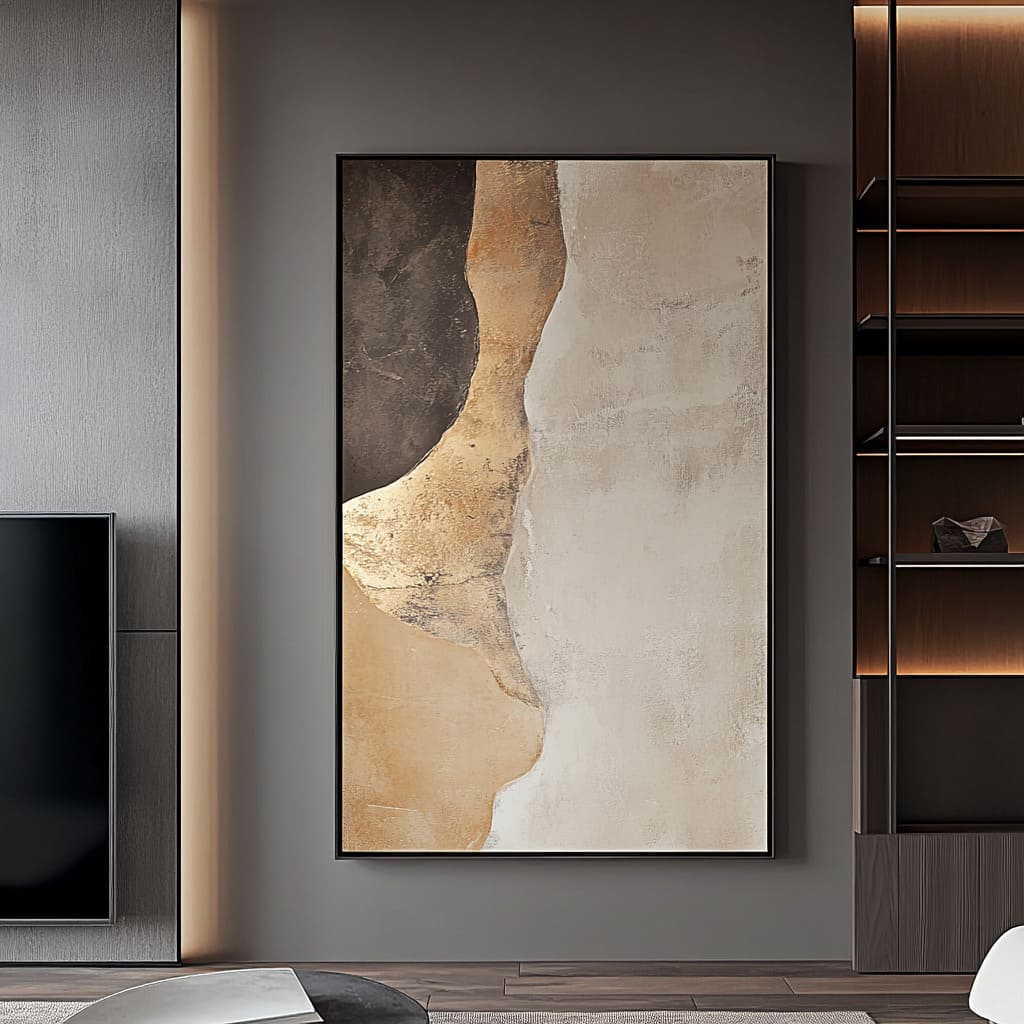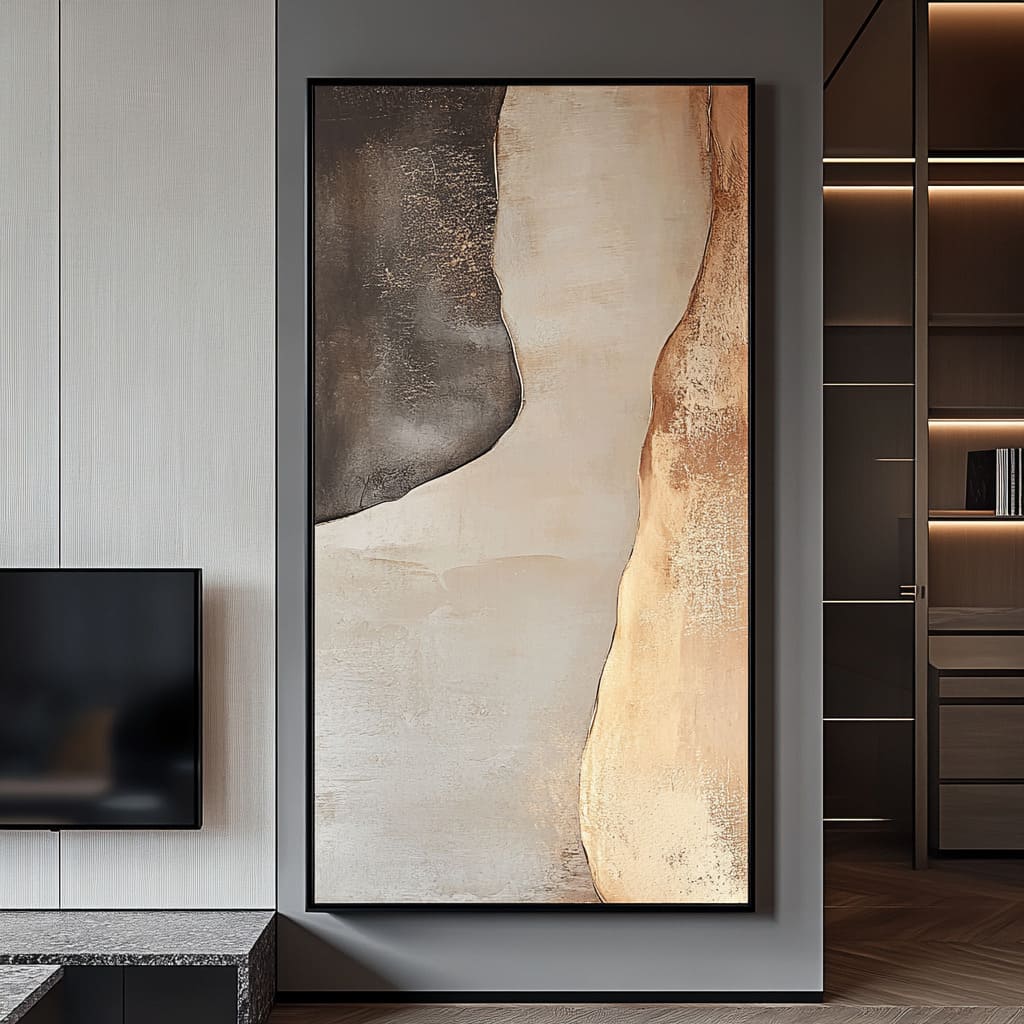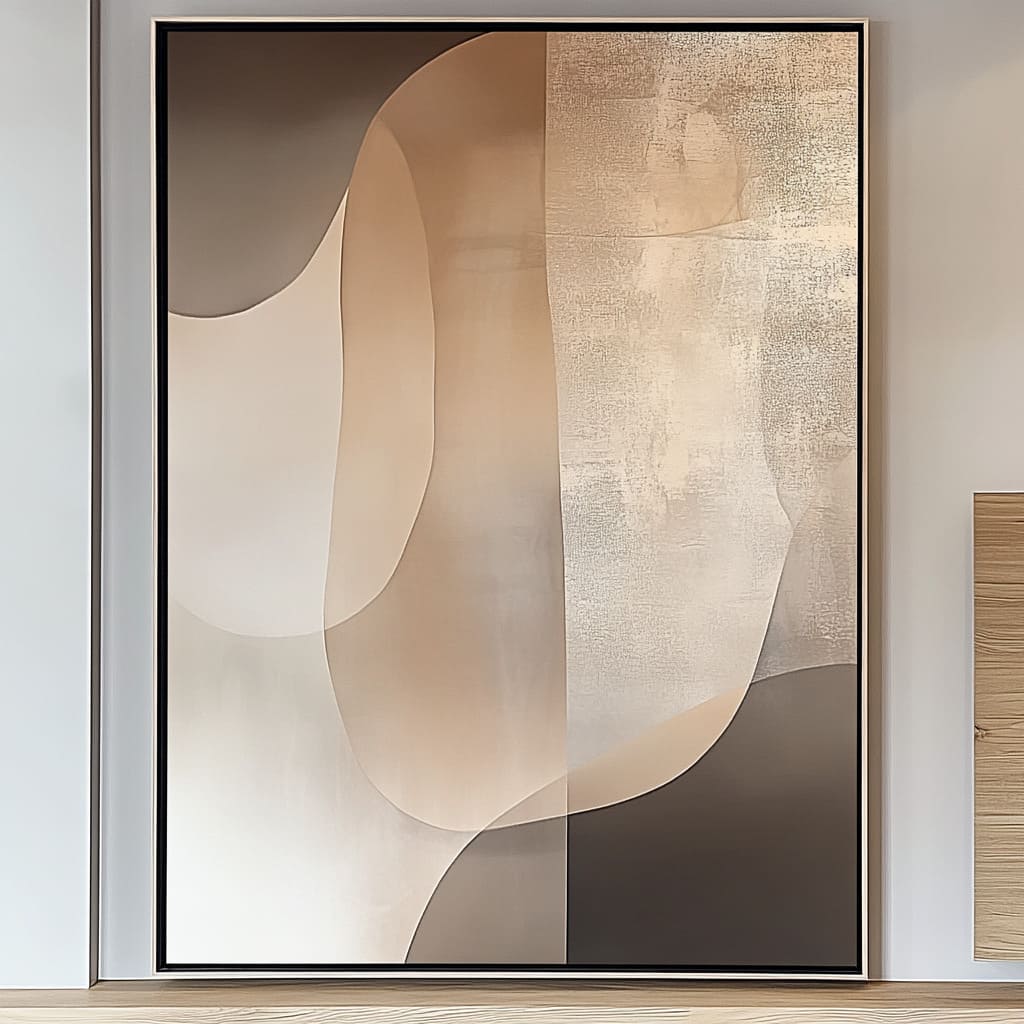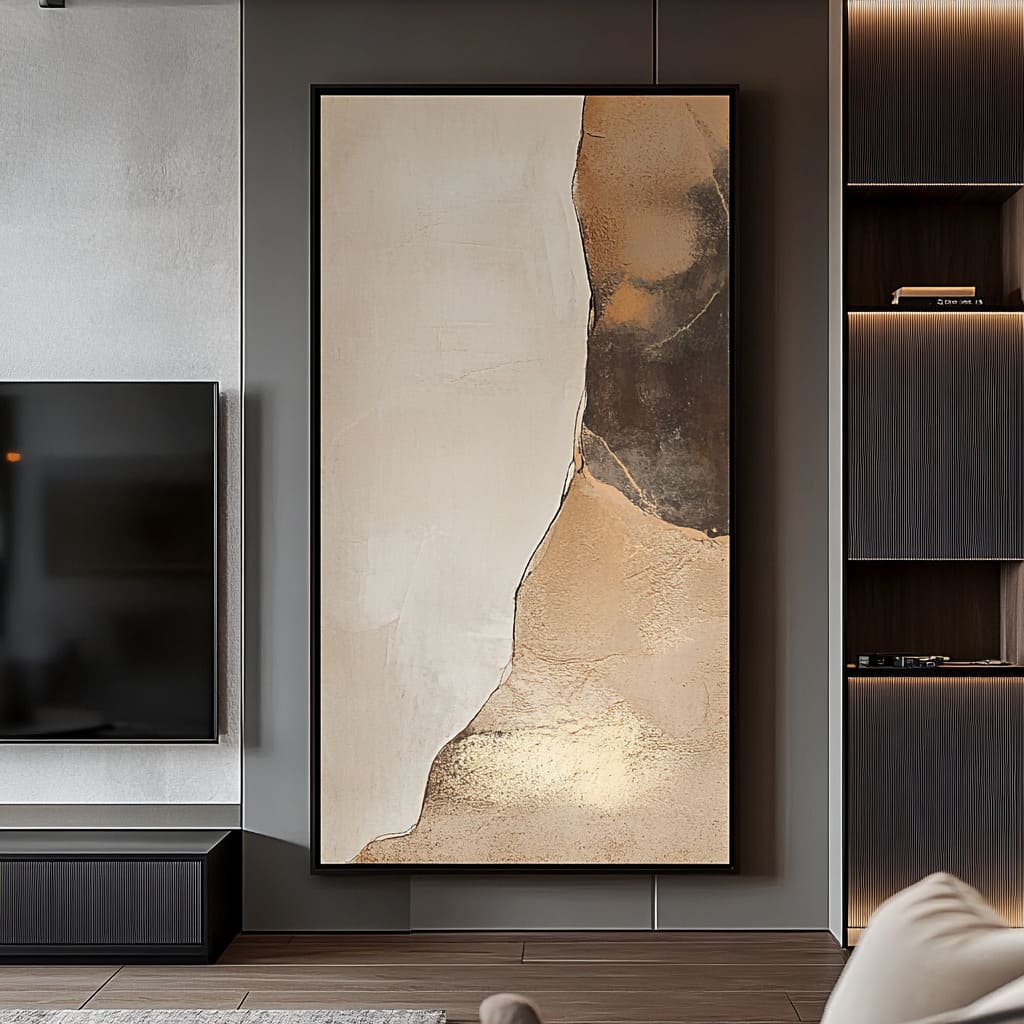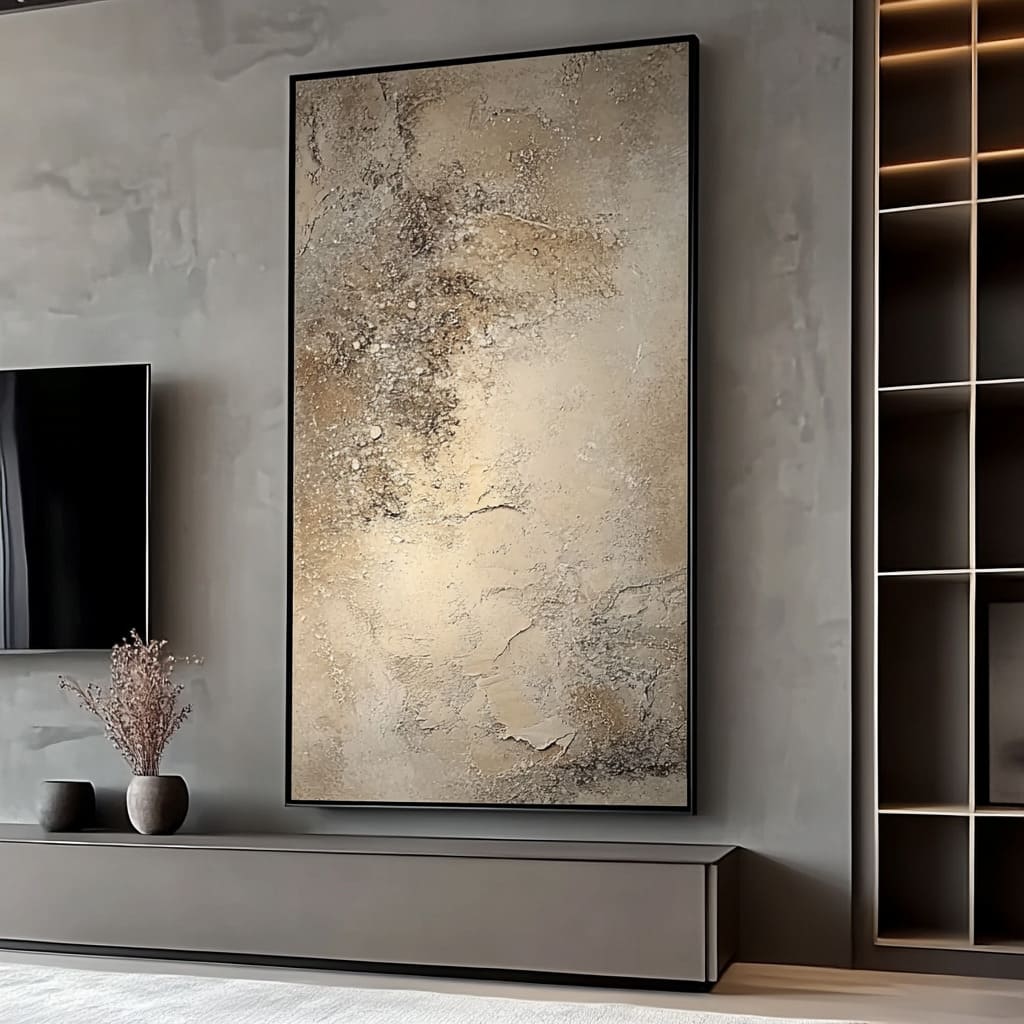In modern interior design, the relationship between art and space is increasingly emphasized, with abstract art playing a pivotal role in shaping the atmosphere and character of a room. Abstract pieces, particularly those rich in texture and form, do more than decorate—they engage with the architecture and furnishings, influencing how the space is perceived and experienced. This article will delve into the nuanced ways in which texture and form in abstract art contribute to the depth and complexity of contemporary interiors, offering insights into how these elements can be effectively integrated into home or office settings
The Role of Texture in Abstract Art
Texture in art refers to the surface quality of a piece—whether it appears rough, smooth, grainy, or soft to the eye and touch. This element is crucial in abstract art, as it brings an additional layer of sensory engagement. Unlike representational art, where the subject matter itself might carry the weight of the message, abstract art often relies on texture to convey emotion and meaning.
The tactile nature of textured art invites the viewer to interact with it, not just visually but also imaginatively, evoking a sensory response that flat, untextured surfaces cannot achieve. The importance of texture in abstract art lies in its ability to transform a simple shape or color into something more profound, adding depth and dimension that can alter the viewer’s perception of both the artwork and the space it inhabits
Artists employ various methods to introduce texture into their work, each technique contributing to the final impact of the piece. Layering is a fundamental approach where multiple coats of paint or other materials are applied over time, creating a complex surface with varying degrees of thickness and depth. This technique allows the artist to build up the surface, adding a sense of history or progression within the artwork.
In some pieces, artists use tools like palette knives or brushes to scrape away layers, revealing underpainting or raw canvas, which adds a sense of rawness and authenticity. Other techniques might include the use of mixed media—such as incorporating sand, fabric, or paper into the paint—to create a surface that invites touch.
These methods result in a finished piece that is rich in texture, engaging viewers on a physical level and inviting them to explore the artwork beyond its visual components.
Incorporating textured abstract art into an interior space can dramatically change the room’s dynamics. Textured art interacts with light differently than flat art, creating shadows and highlights that shift throughout the day, bringing the artwork to life and adding a dynamic quality to the space. This interaction can make a minimalist interior feel warmer and more inviting, as the texture introduces a tactile element that contrasts with sleek, smooth surfaces.
For example, in a room dominated by modern materials like glass, metal, and polished wood, a textured painting can soften the overall feel, creating a balanced and harmonious environment. The artwork becomes a focal point, drawing the eye and providing a counterpoint to the room’s clean lines and sharp angles. Additionally, the texture can make a space feel more intimate, as it invites closer inspection and personal engagement
The Power of Form in Abstract Art
In abstract art, form takes on a different role than in traditional representational art. Abstract forms are not about depicting the physical world but about evoking ideas, emotions, or states of being through shapes and lines. These forms can be geometric, with sharp angles and clear edges, or organic, with fluid, curving lines.
The choice of form in an artwork can influence how the viewer feels when interacting with it. Large, sweeping forms can create a sense of expansiveness and freedom, while smaller, more contained shapes can evoke a feeling of introspection or tension. The abstract forms described in the artworks discussed earlier demonstrate the power of shape to dominate a space, guiding the viewer’s eye and creating a narrative within the room.
These forms are not passive—they actively engage with the surrounding environment, altering the viewer’s perception of the space.
The relationship between form and space in abstract art is critical to the artwork’s impact. How a form is placed within the canvas—whether it dominates the space, shares it equally, or retreats into the background—affects the overall balance and harmony of the piece. In the artworks discussed, large, asymmetrical forms create a dynamic interaction with the surrounding space, leading the eye across the canvas in a fluid, almost rhythmic manner.
This balance between positive and negative space—where the form meets the background—determines the energy and flow of the piece. In a room, this balance can be mirrored in the placement of the artwork itself, with careful consideration of how it interacts with the surrounding elements such as furniture, architecture, and lighting. The form within the artwork can echo or contrast with the shapes in the room, creating a dialogue that enriches both the art and the interior
Abstract forms are particularly effective in creating focal points within a room. Unlike representational art, which might draw attention through subject matter, abstract art captures the viewer’s eye through the use of bold shapes and strategic placement. A large, prominent form within a piece of abstract art can anchor a room, giving it a sense of purpose and direction.
In the described examples, where large, curved forms dominate the canvas, these shapes command attention and serve as the centerpiece of the space. The form becomes a visual anchor, around which other elements of the room can be arranged, creating a cohesive and intentional design. This approach is particularly effective in open-plan spaces or rooms with high ceilings, where a strong focal point is needed to ground the room and create a sense of intimacy.
Integrating Abstract Art into Contemporary Spaces
Selecting the right piece of abstract art for a contemporary space requires careful consideration of both the artwork’s characteristics and the room’s existing design elements. The texture and form of the artwork should complement the room’s materials, colors, and overall aesthetic. For instance, in a room with a neutral color scheme, an abstract piece with rich texture and subtle color variations can add depth without overwhelming the space.
Conversely, in a room with bold colors and patterns, a piece with more restrained texture and form might provide the needed balance. The scale of the artwork is also important—larger pieces can dominate a wall and become the focal point, while smaller pieces might be better suited for grouping or for spaces where a more subtle impact is desired. The artworks described in this discussion serve as excellent examples of how to match texture and form with the intended ambiance of the room, whether it’s to create a sense of warmth, introduce a bold statement, or add a touch of sophistication
Where and how artwork is placed in a room can significantly influence its impact. Strategic placement involves considering the room’s layout, the function of the space, and how the artwork will be viewed from different angles. For textured abstract art, lighting plays a crucial role in highlighting the nuances of the surface.
Natural light can bring out the variations in texture throughout the day, while targeted artificial lighting, such as track lights or picture lights, can emphasize specific areas of the artwork, adding depth and drama. The examples provided earlier show how well-placed art can interact with lighting to create a shifting focal point that enhances the room’s ambiance. In a living room, for instance, placing a textured piece near a light source can create shadows that change with the time of day, adding a dynamic quality to the artwork and the space
Integrating abstract art into a room is not just about choosing the right piece but also about ensuring it works harmoniously with the existing design. The balance between the boldness of abstract forms and the overall aesthetic of the room is key to achieving a cohesive look. If the artwork features strong, dominant forms, the surrounding decor might need to be more subdued to allow the art to stand out without competing for attention.
Conversely, in a minimalist space, the art might need to carry more visual weight to prevent the room from feeling too sparse. The interaction between the artwork and the surrounding elements—such as furniture placement, color schemes, and architectural features—can create a sense of unity within the space. The rooms discussed earlier demonstrate how abstract art, with its emphasis on texture and form, can either complement or contrast with the room’s design, creating a balanced and thoughtfully curated environment
How does the interplay between abstract art and natural light specifically alter the mood and perception of a living room throughout the day?
The interplay between abstract art and natural light can significantly alter the mood and perception of a living room throughout the day by creating dynamic changes in how the artwork is experienced. As natural light shifts in intensity and angle from morning to evening, it interacts with the texture and form of the abstract art in unique ways.
In the morning, soft, diffused light may gently highlight the subtleties of the artwork’s texture, bringing out delicate details and creating a calm, inviting atmosphere. As the day progresses and the light becomes more direct and intense, the artwork might cast sharper shadows or reveal more vivid contrasts between different colors and forms, adding energy and vibrancy to the space.
During the late afternoon or early evening, as the light becomes warmer and more angled, the artwork can take on a different character entirely, with shadows lengthening and certain textures becoming more pronounced. This can evoke a sense of depth and complexity, potentially making the living room feel more intimate or contemplative
Overall, the changing interplay between natural light and abstract art ensures that the living room evolves throughout the day, with the artwork contributing to a dynamic and engaging environment that reflects different moods and perceptions depending on the time of day
In what ways can the texture and form of abstract art impact the psychological and emotional experience of a living room, particularly in a minimalist or open-plan layout?
The texture and form of abstract art can have a profound impact on the psychological and emotional experience of a living room, especially in a minimalist or open-plan layout. In minimalist spaces, where the design is often characterized by clean lines and simplicity, the introduction of textured abstract art adds a layer of richness and complexity that engages the senses. This tactile quality invites closer interaction, encouraging the viewer to explore the art on a more intimate level, which can evoke feelings of warmth and comfort in an otherwise sparse environment
The form of abstract art, whether geometric or organic, plays a significant role in shaping the emotional tone of the room. Geometric forms might introduce a sense of structure and order, contributing to a calm and balanced atmosphere. In contrast, organic shapes can add a sense of flow and movement, which might create a more dynamic and lively environment.
In an open-plan layout, these forms can help define different areas of the space, guiding the eye and subtly influencing how the room is navigated.
Texture in abstract art also interacts with light in ways that can alter the mood of the living room. Rough or layered textures may create shadows and highlights that change throughout the day, adding depth and variation to the room’s ambiance. This interaction can make the space feel more inviting and less static, enhancing the emotional experience of those who inhabit it
Overall, the integration of textured and thoughtfully formed abstract art in a minimalist or open-plan living room can transform the space from being purely functional to being emotionally resonant, providing both visual interest and a deeper sensory engagement that enriches the overall experience of the room
How do architectural features, such as high ceilings or asymmetrical walls, influence the effectiveness of abstract art as a focal point in contemporary spaces?
Architectural features such as high ceilings or asymmetrical walls can significantly influence the effectiveness of abstract art as a focal point in contemporary spaces. High ceilings offer an expansive canvas that allows larger pieces of abstract art to dominate the space, making a powerful visual statement that draws the eye upward. This vertical emphasis can create a sense of grandeur and openness, enhancing the room’s overall aesthetic and making the art feel monumental within the space
Asymmetrical walls, on the other hand, introduce a unique challenge and opportunity for displaying abstract art. The irregular angles and unconventional layouts of such walls can be complemented by the dynamic forms of abstract pieces, creating a harmonious balance that accentuates both the artwork and the architecture. In these settings, abstract art can be used to either counterbalance the irregularities or to emphasize them, depending on the desired effect.
When placed on asymmetrical walls, abstract art can guide the viewer’s eye along the room’s natural lines, creating a visual flow that feels intentional and thoughtfully curated. This can make the space feel more cohesive, even if the architecture itself is unconventional.
High ceilings, combined with large-scale abstract art, can also influence the room’s acoustics and overall atmosphere, making it feel more expansive and airy, while the art provides a grounded focal point that ties the design together
Overall, architectural features like high ceilings and asymmetrical walls do more than provide a backdrop for abstract art—they actively shape how the art is perceived and experienced, amplifying its impact and ensuring that it becomes a central element of the room’s design
Textured and Form-Driven Abstract Art in Action
Large-scale abstract art can have a profound impact on a space, especially when it incorporates significant texture and bold forms. These pieces often become the defining feature of a room, drawing the eye and setting the tone for the rest of the design. In the examples discussed, such as the vertically oriented artworks that occupy entire sections of a wall, the scale of the art commands attention and provides a sense of structure within the room.
The texture of these large pieces adds a tactile element that encourages closer inspection, while the form creates a visual anchor around which the rest of the room’s elements can be arranged. The interplay between these large-scale artworks and the room’s architecture, particularly in spaces with high ceilings or open floor plans, creates a dramatic and engaging environment that feels both cohesive and dynamic
Abstract art with a neutral palette offers a subtle yet effective way to introduce texture and form into a room without overwhelming the space. These pieces often rely on variations in tone and texture to create interest, rather than bold colors or intricate patterns. In the artworks discussed, neutral tones such as beige, cream, and grey are used to create a calming and sophisticated atmosphere.
The texture within these pieces adds depth, while the abstract forms provide a focal point that draws the eye without dominating the room. This approach is particularly effective in minimalist or monochromatic spaces, where the artwork can enhance the room’s existing color scheme while adding a layer of complexity. The balance of texture and form in these neutral palette pieces allows them to complement a wide range of interior styles, from modern to traditional, making them a versatile choice for contemporary spaces.
The Emotional and Psychological Impact of Texture and Form
Texture in abstract art can evoke a wide range of emotions and set the mood for a space. Rough, gritty textures might suggest rawness and earthiness, while smoother textures can convey calm and refinement. The textured surfaces described earlier bring a sense of physicality to the artwork, making it more than just a visual experience.
These textures can transform the atmosphere of a room, making it feel more intimate or grounded. For instance, a textured piece in a living room might create a cozy, inviting ambiance, while in a dining room, it might add a sense of sophistication and depth. The texture interacts with the room’s lighting and furnishings, contributing to the overall emotional tone of the space.
Abstract forms have a unique ability to convey emotions and concepts without relying on representational imagery. The shapes and lines within an abstract piece can suggest movement, energy, calm, or tension, depending on their arrangement and interaction with the surrounding space. The forms described in the earlier artworks, whether large and sweeping or small and contained, reflect a range of emotions that can influence how a room feels.
For example, a large, curved form might evoke a sense of flow and continuity, while a sharp, angular shape could introduce a sense of excitement or tension. The viewer’s emotional response to these forms is often subconscious, influenced by their personal experiences and the context of the room. This emotional impact makes abstract art a powerful tool in interior design, capable of shaping the viewer’s experience of a space
Conclusion
Texture and form are essential elements in abstract art that contribute to the depth and dimension of contemporary spaces. Through careful selection and thoughtful placement, these artworks can enhance the character of a room, adding layers of interest and engaging the viewer on both a visual and sensory level. The integration of textured and form-driven abstract art into modern interiors is not just about decoration—it’s about creating a dialogue between the art and the space, where each enhances and complements the other. As interior design continues to evolve, the role of abstract art, with its emphasis on texture and form, will remain a vital aspect of creating environments that are both aesthetically pleasing and emotionally resonant
Incorporating such pieces into your home or office is an investment in the space’s atmosphere and a reflection of the unique interplay between art and design. The possibilities are as varied as the artworks themselves, offering endless opportunities to transform and enrich your surroundings. Whether you are drawn to the tactile richness of textured surfaces or the dynamic energy of abstract forms, the right piece of art can elevate your space, making it more than just a place to live or work, but a space that inspires and engages.
